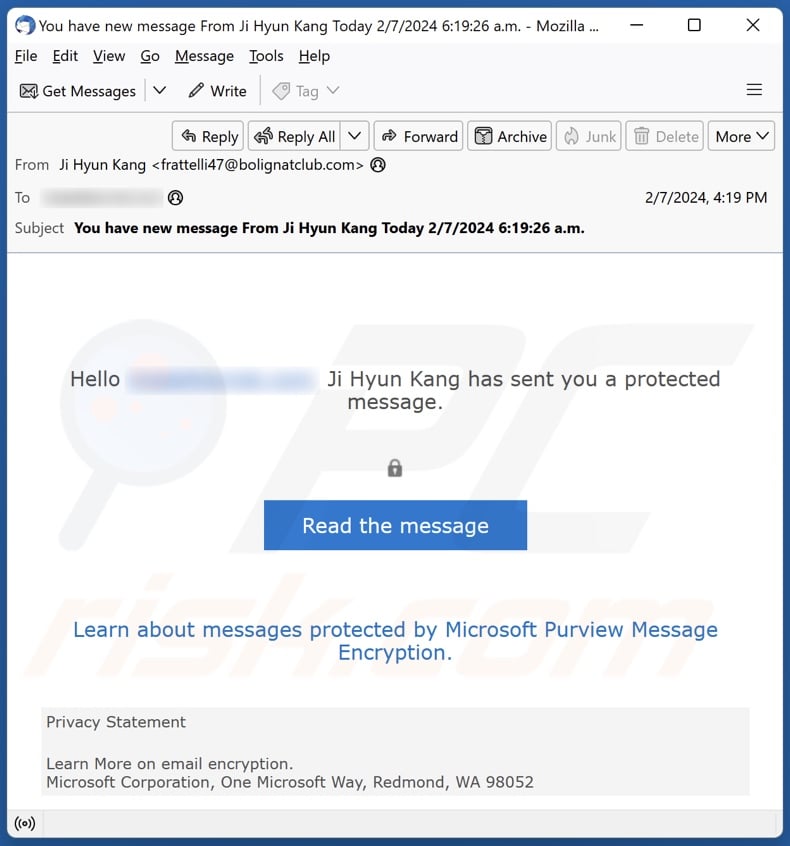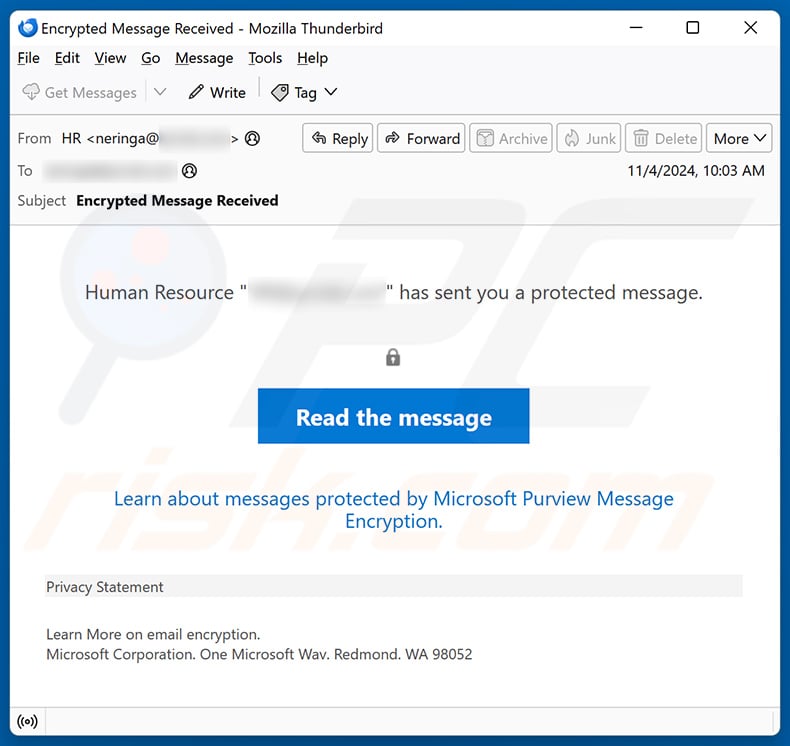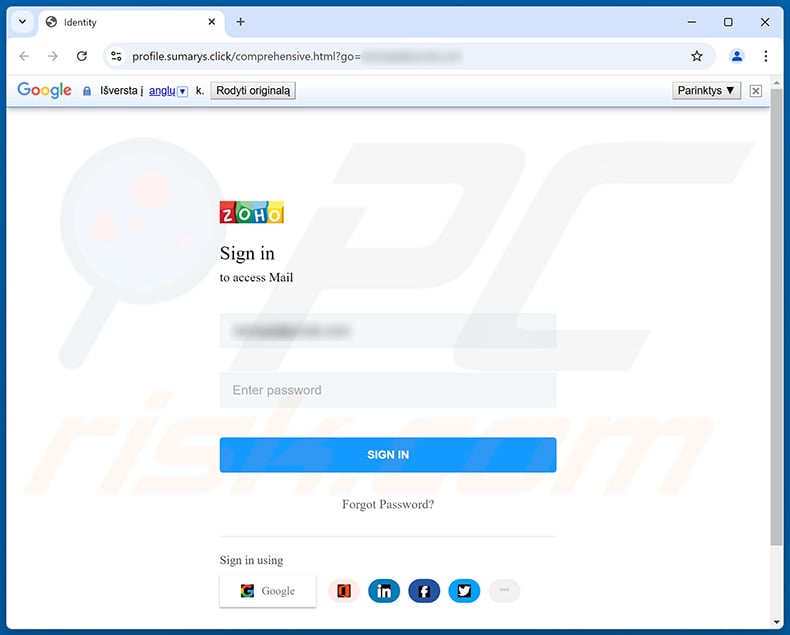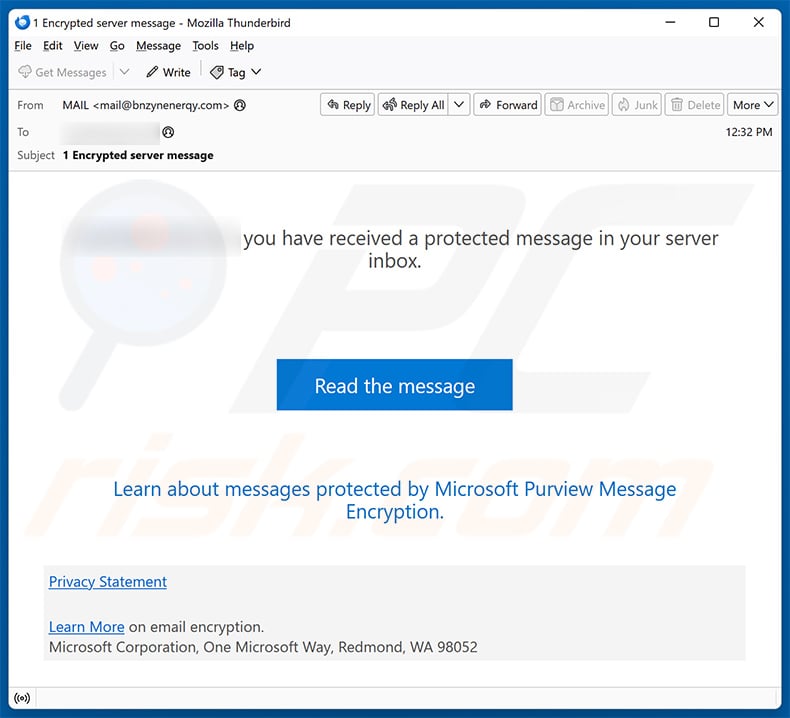Avoid having your email account stolen via fake "Protected Message" emails
Phishing/ScamAlso Known As: "Protected Message" phishing email
Get free scan and check if your device is infected.
Remove it nowTo use full-featured product, you have to purchase a license for Combo Cleaner. Seven days free trial available. Combo Cleaner is owned and operated by RCS LT, the parent company of PCRisk.com.
What kind of email is "Protected Message"?
After inspecting the "Protected Message" email, we determined that it is spam. The letter states that the recipient has been sent an encryption-protected message. The goal of this mail is to deceive users into providing their log-in credentials to a phishing website.

"Protected Message" email scam overview
The spam email has the subject "You have new message From Ji Hyun Kang Today 2/7/2024 6:19:26 a.m." (may vary). The letter informs that the recipient was sent a message, which was encrypted for protection. This spam also name-drops Microsoft to create an impression of legitimacy.
It must be emphasized that the information in the email is false, and this mail is not associated with Microsoft's products/services or any other legitimate entities.
When the "Read the message" button is pressed, it results in a redirect to a phishing website disguised as an email sign-in page. Log-in credentials (passwords) entered into this site will be recorded and sent to cyber criminals. It has to be mentioned that through a hijacked email, access might be gained to the accounts and platforms connected to it.
To expand some on the potential misuse, scammers can steal the identities of social account owners (e.g., emails, social networking, social media, chats, etc.) and ask the contacts/friends/followers for loans or donations, promote scams, and spread malware by sharing malicious links/files.
Furthermore, finance-related accounts (e.g., online banking, e-commerce, digital wallets, etc.) can be used to make fraudulent transactions and online purchases. What is more, sensitive/compromising content discovered on compromised data storage or similar platforms – could be used for blackmail or other malicious purposes.
To summarize, victims of spam mail like "Protected Message" can experience serious privacy issues, financial losses, and even identity theft.
If you have already disclosed your account credentials – immediately change the passwords of all possibly exposed accounts and inform their official support.
| Name | "Protected Message" phishing email |
| Threat Type | Phishing, Scam, Social Engineering, Fraud |
| Fake Claim | Recipient was sent a protected message. |
| Disguise | Microsoft |
| Symptoms | Unauthorized online purchases, changed online account passwords, identity theft, illegal access of the computer. |
| Distribution methods | Deceptive emails, rogue online pop-up ads, search engine poisoning techniques, misspelled domains. |
| Damage | Loss of sensitive private information, monetary loss, identity theft. |
| Malware Removal (Windows) |
To eliminate possible malware infections, scan your computer with legitimate antivirus software. Our security researchers recommend using Combo Cleaner. Download Combo CleanerTo use full-featured product, you have to purchase a license for Combo Cleaner. 7 days free trial available. Combo Cleaner is owned and operated by RCS LT, the parent company of PCRisk.com. |
Phishing spam campaign examples
We have analyzed countless spam emails; "Confirm If The Prices Are Still Valid", "DHL Global Express Shipping", "Publishers Clearing House", and "Asian Welfare Lottery" are but a few examples of ones used for phishing. Note that this mail facilitates various scams and proliferates malware.
While the commonly held belief that spam emails are full of spelling and grammatical errors is not incorrect, it is not exclusively true. These letters may be competently made and even disguised as messages from legitimate service providers, companies, organizations, institutions, and other entities.
How do spam campaigns infect computers?
Spam campaigns are often used to spread malware. These emails/messages can include malicious files as attachments or download links. Infectious files can be archives (ZIP, RAR, etc.), executables (.exe, .run, etc.), documents (Microsoft Office, Microsoft OneNote, PDF, etc.), JavaScript, and so on.
Upon being opened, a virulent file triggers the infection chain. However, some formats may need additional actions to start downloading/installing malware. For example, Microsoft Office files require users to enable macro commands (i.e., editing/content), while OneNote documents need them to click on embedded files/links.
How to avoid installation of malware?
We highly recommend being careful with incoming emails, PMs/DMs, SMSes, and other messages. Attachments or links found in suspicious/irrelevant mail must not be opened, as they can be malicious. Another recommendation is to use Microsoft Office versions released after 2010 since they have the "Protected View" mode that prevents automatic macro command execution.
However, malware is not distributed exclusively via spam mail. Fake and malicious online content usually appears genuine and harmless – therefore, we advise being careful while browsing.
Additionally, all downloads must be performed from official and verified sources. It is just as important to activate and update software using legitimate functions/tools, as illegal activation tools ("cracks") and third-party updates may contain malware.
We must emphasize that having a dependable anti-virus installed and kept up-to-date is paramount to device/user safety. Security programs must be used to run regular system scans and to remove detected threats and issues. If you've already opened malicious attachments, we recommend running a scan with Combo Cleaner Antivirus for Windows to automatically eliminate infiltrated malware.
Text presented in the "Protected Message" spam email letter:
Subject: You have new message From Ji Hyun Kang Today 2/7/2024 6:19:26 a.m.
Hello ********, Ji Hyun Kang has sent you a protected message.
Read the message
Learn about messages protected by Microsoft Purview Message Encryption.
Privacy Statement
Learn More on email encryption.
Microsoft Corporation, One Microsoft Way, Redmond, WA 98052
Screenshot of the phishing website promoted by the "Protected Message" spam campaign:

Other examples of protected message-themed spam emails:
Sample 1:

Text presented within:
Subject: Encrypted Message Received
Human Resource "********" has sent you a protected message.
Read the message
Learn about messages protected by Microsoft Purview Message Encryption.
Privacy Statement
Learn More on email encryption.
Microsoft Corporation. One Microsoft Wav. Redmond. WA 98052
Screenshot of the promoted phishing site:

Sample 2:

Text presented within:
Subject: 1 Encrypted server message
******** you have received a protected message in your server inbox.
Read the message
Learn about messages protected by Microsoft Purview Message Encryption.
Privacy StatementLearn More on email encryption.
Microsoft Corporation, One Microsoft Way, Redmond, WA 98052
Instant automatic malware removal:
Manual threat removal might be a lengthy and complicated process that requires advanced IT skills. Combo Cleaner is a professional automatic malware removal tool that is recommended to get rid of malware. Download it by clicking the button below:
DOWNLOAD Combo CleanerBy downloading any software listed on this website you agree to our Privacy Policy and Terms of Use. To use full-featured product, you have to purchase a license for Combo Cleaner. 7 days free trial available. Combo Cleaner is owned and operated by RCS LT, the parent company of PCRisk.com.
Quick menu:
- What is "Protected Message" phishing email?
- Types of malicious emails.
- How to spot a malicious email?
- What to do if you fell for an email scam?
Types of malicious emails:
![]() Phishing Emails
Phishing Emails
Most commonly, cybercriminals use deceptive emails to trick Internet users into giving away their sensitive private information, for example, login information for various online services, email accounts, or online banking information.
Such attacks are called phishing. In a phishing attack, cybercriminals usually send an email message with some popular service logo (for example, Microsoft, DHL, Amazon, Netflix), create urgency (wrong shipping address, expired password, etc.), and place a link which they hope their potential victims will click on.
After clicking the link presented in such email message, victims are redirected to a fake website that looks identical or extremely similar to the original one. Victims are then asked to enter their password, credit card details, or some other information that gets stolen by cybercriminals.
![]() Emails with Malicious Attachments
Emails with Malicious Attachments
Another popular attack vector is email spam with malicious attachments that infect users' computers with malware. Malicious attachments usually carry trojans that are capable of stealing passwords, banking information, and other sensitive information.
In such attacks, cybercriminals' main goal is to trick their potential victims into opening an infected email attachment. To achieve this goal, email messages usually talk about recently received invoices, faxes, or voice messages.
If a potential victim falls for the lure and opens the attachment, their computers get infected, and cybercriminals can collect a lot of sensitive information.
While it's a more complicated method to steal personal information (spam filters and antivirus programs usually detect such attempts), if successful, cybercriminals can get a much wider array of data and can collect information for a long period of time.
![]() Sextortion Emails
Sextortion Emails
This is a type of phishing. In this case, users receive an email claiming that a cybercriminal could access the webcam of the potential victim and has a video recording of one's masturbation.
To get rid of the video, victims are asked to pay a ransom (usually using Bitcoin or another cryptocurrency). Nevertheless, all of these claims are false - users who receive such emails should ignore and delete them.
How to spot a malicious email?
While cyber criminals try to make their lure emails look trustworthy, here are some things that you should look for when trying to spot a phishing email:
- Check the sender's ("from") email address: Hover your mouse over the "from" address and check if it's legitimate. For example, if you received an email from Microsoft, be sure to check if the email address is @microsoft.com and not something suspicious like @m1crosoft.com, @microsfot.com, @account-security-noreply.com, etc.
- Check for generic greetings: If the greeting in the email is "Dear user", "Dear @youremail.com", "Dear valued customer", this should raise suspiciousness. Most commonly, companies call you by your name. Lack of this information could signal a phishing attempt.
- Check the links in the email: Hover your mouse over the link presented in the email, if the link that appears seems suspicious, don't click it. For example, if you received an email from Microsoft and the link in the email shows that it will go to firebasestorage.googleapis.com/v0... you shouldn't trust it. It's best not to click any links in the emails but to visit the company website that sent you the email in the first place.
- Don't blindly trust email attachments: Most commonly, legitimate companies will ask you to log in to their website and to view any documents there; if you received an email with an attachment, it's a good idea to scan it with an antivirus application. Infected email attachments are a common attack vector used by cybercriminals.
To minimise the risk of opening phishing and malicious emails we recommend using Combo Cleaner Antivirus for Windows.
Example of a spam email:

What to do if you fell for an email scam?
- If you clicked on a link in a phishing email and entered your password - be sure to change your password as soon as possible. Usually, cybercriminals collect stolen credentials and then sell them to other groups that use them for malicious purposes. If you change your password in a timely manner, there's a chance that criminals won't have enough time to do any damage.
- If you entered your credit card information - contact your bank as soon as possible and explain the situation. There's a good chance that you will need to cancel your compromised credit card and get a new one.
- If you see any signs of identity theft - you should immediately contact the Federal Trade Commission. This institution will collect information about your situation and create a personal recovery plan.
- If you opened a malicious attachment - your computer is probably infected, you should scan it with a reputable antivirus application. For this purpose, we recommend using Combo Cleaner Antivirus for Windows.
- Help other Internet users - report phishing emails to Anti-Phishing Working Group, FBI’s Internet Crime Complaint Center, National Fraud Information Center and U.S. Department of Justice.
Frequently Asked Questions (FAQ)
Why did I receive this email?
Spam emails are not personal, even if they include details relevant to the recipients. This mail is distributed in massive campaigns – therefore, thousands of users receive identical messages.
I have provided my personal information when tricked by this spam email, what should I do?
If you've provided your log-in credentials – immediately change the passwords of all possibly exposed accounts and contact their official support. However, if you have disclosed other private information (e.g., ID card details, credit card numbers, etc.) – contact the corresponding authorities without delay.
I have read a spam email but didn't open the attachment, is my computer infected?
No, merely opening/reading an email is harmless. Devices are infected when malicious attachments or links are opened/clicked.
I have downloaded and opened a file attached to a spam email, is my computer infected?
Whether the system was compromised might depend on the format of the opened file. If it was an executable (.exe, .run, etc.) – most likely, yes. However, you might have avoided an infection if it was a document (.doc, .xls, .pdf, .one, etc.). These formats may require extra actions (e.g., enabling macro commands, clicking embedded files/links, etc.) to initiate infection chains.
Will Combo Cleaner remove malware infections present in email attachments?
Yes, Combo Cleaner is capable of detecting and eliminating nearly all known malware infections. It must be mentioned that running a full system scan is essential since sophisticated malicious programs usually hide deep within systems.
Share:

Tomas Meskauskas
Expert security researcher, professional malware analyst
I am passionate about computer security and technology. I have an experience of over 10 years working in various companies related to computer technical issue solving and Internet security. I have been working as an author and editor for pcrisk.com since 2010. Follow me on Twitter and LinkedIn to stay informed about the latest online security threats.
PCrisk security portal is brought by a company RCS LT.
Joined forces of security researchers help educate computer users about the latest online security threats. More information about the company RCS LT.
Our malware removal guides are free. However, if you want to support us you can send us a donation.
DonatePCrisk security portal is brought by a company RCS LT.
Joined forces of security researchers help educate computer users about the latest online security threats. More information about the company RCS LT.
Our malware removal guides are free. However, if you want to support us you can send us a donation.
Donate
▼ Show Discussion